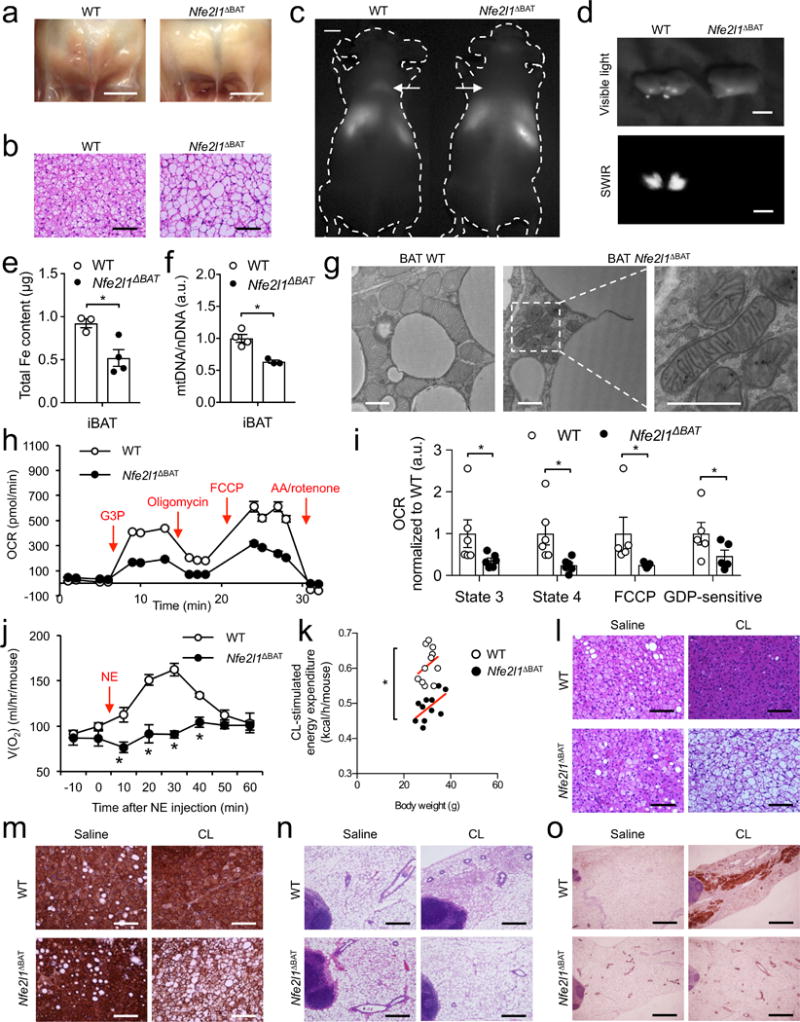Figure 3.

Nrf1 is a fundamental regulator of BAT adaptation. (a) Photographs of iBAT (Scale bars, 5 mm) and (b) Hematoxylin & Eosin (H&E)-stained histology (Scale bars, 100 μm) of WT and Nfe2l1ΔBAT mice at 22 °C. (c) Short-wave infrared (SWIR) imaging of WT mice and Nfe2l1ΔBAT. Arrows indicate interscapular BAT (d) Ex vivo SWIR and visible light imaging of iBAT from (c) (Scale bars in c,d, 5 mm). (e) Iron and (f) mitochondrial DNA content in iBAT of WT and Nfe2l1ΔBAT mice at 22 °C (Biol. replicates (e) n = 3 for WT and n = 4 for Nfe2l1ΔBAT and (f) n = 4 for WT and n = 3 for Nfe2l1ΔBAT, *P < 0.05 by Student’s t-Test). (g) Representative electron microscopy of iBAT of WT and Nfe2l1ΔBAT mice at 22 °C (biol. replicates n = 3, Scale bars, 1 μm) (h) Oxygen consumption rate (OCR) in mitochondria isolated from WT and Nfe2l1ΔBAT mice at 22 °C (G3P: Glycerol-3-phosphate, FCCP: Carbonyl cyanide-4-(trifluoromethoxy)phenylhydrazone, AA: Antimycin A; representative traces) (i) State 3, state 4, FCCP-induced and GDP-sensitive OCR in mitochondria isolated from WT and Nfe2l1ΔBAT mice at 22 °C (Biol. replicates n = 6 for state 3 and state 4, n = 5 for FCCP and GDP, *P < 0.05 by Mann-Whitney-U rank test). (j) Norepinephrine (NE)-stimulated whole-body oxygen consumption in WT and Nfe2l1ΔBAT mice at 22 °C (Biol. replicates n = 4, *P < 0.05 by Student’s t-Test). (k) CL316,243 (CL)-stimulated whole-body energy expenditure in WT and Nfe2l1ΔBAT mice at 22 °C (Biol. replicates n = 8, *P < 0.05 by T-Test). (l-o) Representative H&E histology (l) and Ucp1 immunohistochemistry (IHC) (m) of iBAT as well as H&E histology (n) and Ucp1 IHC (o) of inguinal white adipose tissue from WT and Nfe2l1ΔBAT mice at 30 °C treated with CL or saline (Biol. replicates n = 4. Scale bars in l,m, 100 μm; in n, 0.4 mm; in o, 1 mm).
